For many years now I have been looking around for someone who replates saxophone mouthpieces. Back in the 90’s, I had a mouthpiece that had the bite plate fall off and then the gold plating was all wearing away. I read about health hazards that could come from playing a raw brass or copper mouthpiece on the internet at that time but I ignored all that as rumors and hogwash.
Although probably unrelated, if you have read my “Funny as a Brain Tumor” story you will see that shortly after that time I was struck down with a brain tumor, cancer, bacterial meningitis twice, Stevens-Johnson Syndrome, increased intracranial pressure, a number of various allergic reactions, depression (who wouldn’t be depressed with all of this…..), back surgery twice, and lastly a ventriculoperitoneal shunt. Although my doctors, during this time, always insisted that playing a raw copper mouthpiece wouldn’t cause all of these issues (Yes, I did indeed ask them this…..), I always had my doubts……..
Around the year 2000 I started to look around to have my mouthpiece replated and have a new bite plate put on. Unfortunately, the company that made it didn’t do replating work on their old mouthpieces and I could find any other company to do it for me. I did hear of “Anderson Plating” but was told that they just plate and I would probably have to send it to a mouthpiece refacer afterwards to have them check it and adjust it. That scared the tar out of me as I really loved this mouthpiece so I never took that chance.
By this time, there was a big hunk of copper missing out of the mouthpiece where my teeth usually sit on the top (I didn’t like mouthpiece patches back then as I felt they changed the sound I was hearing in my head.) I decided to retire the old girl and it went into the infamous mouthpiece drawer where all loyal beatup mouthpieces go to live out their end days.
Now 17 years later, I have two Otto Links that I really love but when I got them they were raw brass. I was kind of joking above with my list of medical problems and all that but at the same time, I can’t help but think about some of the rumors I have heard people spout on the internet every time I play these two mouthpieces. You read words like metallic poisoning, lead leaching, allergic, brass poisoning, etc…… Here’s a picture of the two mouthpieces:
Bare Brass Double Ring Otto Link and Florida Otto Link Top View
One is an Otto Link Double Ring 7 that I got in a trade for a Freddie Gregory mouthpiece years ago. The other is an Otto Link Florida model 7*. Both of these were refaced by Brian Powell at some point before I received them. As you can see, there is not an ounce of plating left on these two mouthpieces. It’s almost like they were stripped down to the raw brass by someone on purpose.
Bare Brass Double Ring Otto Link and Florida Otto Link Table View
Bare Brass Double Ring Otto Link and Florida Otto Link View from Above
I read on SOTW that Matt Marantz was fiddling around with plating mouthpiece back in 2016 sometime and it caught my attention. I was a bit nervous to send him anything I really cared about back then as he admitted that he was still experimenting and getting things figured out. This year he sounded more confident and the pictures of his work he was posting online looked incredible. I decided to take a chance……
After communicating with Matt about the process and having him assure me that the facings on the mouthpieces would not change to any noticeable degree I sent them off. Three weeks from the date I sent them I received them back and this is the first picture I took. Nice right!
Gold Replated Double Ring Otto Link and Florida Otto Link Top View in Shade
Although the sax mouthpieces don’t look 100% perfect and brand new I am ok with that because they are plated and look a heck of a lot better than raw brass. Matt admitted to me that old sax mouthpieces usually have a lot of imperfections, scratches, bumps and dents you usually don’t see in raw brass but once you put a shiny gold plating on them much is revealed that you couldn’t see before.
Gold Replated Double Ring Otto Link and Florida Otto Link Top View in Sun
Here is a description from Matt Marantz on the work he does while replating:
I can plate it for you in your choice of silver rhodium, black rhodium (like a gunmetal color), or 24k gold. The plating I do involves a strong, thick barrier layer of nickel over the brass before plating a fine metal over it. Unlike some other alloys, brass contains a large percentage of copper so you actually do not need to flash plate a copper layer on brass, you can just plate a nickel barrier then go straight to your fine metal.
My pricing for electroplating is as follows: If someone sends me a pre-polished (by a pro) mouthpiece that is ready to simply electroclean & dip into the plating tanks, I do it for $60. However, 95% of the time there is at least some (or sometimes quite a lot) of cosmetic preparation that needs to be done to achieve a quality result, and the only way you are going to get that service is if you send it to a mouthpiece guy who knows how to prep for plating without changing anything about the facing or the playing characteristics of your (often) prized mouthpiece.
It can take me anywhere from one to two hours to remove scratches, divots, internal machine marks, or anything else that gets in the way of making your mouthpiece look beautiful if the desired result is a quality aesthetically pleasing finish, and for that plating-prep + plating service I charge $100 total. Plating only enhances blemishes, so I try to make it look nice before dipping it in the tank.
Functionally, plating doesn’t change much about the piece other than the fact that your brass will be protected and the mouthpiece may play a little smoother at first because of how clean it will be when you get it back.
The advantage of sending it to someone like me is that I specialize in both mouthpiece work as well as electroplating. I almost gave up on the electroplating last year out of frustration, but I have finally ironed out all the difficulties associated with the semi-mystery behind the electroplating process and currently feel 100% confident about my plating setup. It’s completely a breeze now, just took me a lot of time and practice to figure out how to do it. It is not exactly easy to learn how to do it. I plan to keep using the same formula in the future now that I’ve found a combination of solutions, temperatures, and dip times that work consistently well every time.-Matt Marantz
Let me know if you want to send it in. Contact me at www.marantzcustommouthpieces.com
Gold Replated Double Ring Otto Link and Florida Otto Link Table View
My two Otto Links were totally plating free so as it says the price was either $60 to just plate them and nothing else or $100 to take the time to make them prettier. I ended up paying $100 for each of them.
I actually sent Matt a third mouthpiece that I’m not including in this article because I didn’t get a before picture. It is a RS Berkeley Chris Potter mouthpiece. It has a unique looking brushed look to the unplated raw brass but any time I play it, it ends up looking terrible. Starts turning a shade of dark green and turning all my reeds green as do the two Otto Links above.
I never knew what this green color on my reeds was in the past but Matt was happy to inform all of us on SOTW:
“The green tarnish you see on your mouthpiece is caused by oxidation of the brass, i.e. chemical reactions between the copper in the alloy and the atmosphere of the earth. Copper carbonate is what you most often see showing up on brass. The resultant discoloration is often called patina as well. It is not harmful for you to play this mouthpiece, but it will also turn your reeds green. You’ll notice that if you play a non-plated mouthpiece a lot with cane reeds, and especially if you leave the reed on the mouthpiece overnight as it dries out, you’ll get green discoloration transferred to the reeds as well.” -Matt Marantz
Gold Replated Double Ring Otto Link Top View
Gold Replated Double Ring Otto Link Table View
The second thing I did after opening the package of the returning mouthpieces and visually inspecting them, was to play them. All this pretty gold shine means nothing if it changes how these mouthpieces played for me. First, I tried the Double Ring Otto Link. The reed sealed. That’s a good sign. I played it and it sounded and responded like I remembered. Awesome!
Next I tried the Florida Otto Link and that too sealed and sounded like I had remembered it sounding. No change that I could perceive of. Lastly, I put on the RSBerkeley Chris Potter mouthpiece and that also played exactly like I remembered it.
Whew! This part of it was what I was most anxious about. That being said, this is also why I had confidence in sending these three mouthpieces to Matt Marantz. If nothing else, Matt is very exact, measured and precise in his descriptions and communications. These communications and public posts he has posted have led me to believe he is focused on the minute details. He said the facings would remain the same and he would take every precaution to assure that and I believed him.
Gold Replated Double Ring Otto Link View from Above
Matt is also a phenomenal player besides being a mouthpiece craftsman. He’s not just some tech in the back of a shop plating mouthpieces with no further thoughts about the objects they are plating. Matt knows the value of each mouthpiece and what it means to the customer involved. He knows what it means if he messes up and hurts a prized mouthpiece. He understands the magnitude and importance of the task at hand.
In my mind, these things are what made me take a risk and send them to Matt to have them replated. Usually, I am very worried about this kind of work but I actually slept like a baby for those three weeks. (Except on Thursday when the USPS package was supposed to be delivered and wasn’t…..I was a little restless that night but did receive it Friday afternoon.)
Gold Replated Florida Otto Link Top View
As you examine the pictures you can see small imperfections like I mentioned in the beginning of this post. I believe those are imperfections that were in the raw brass and possibly even fingerprints I didn’t get off the mouthpieces (although I tried like crazy to get every last one off…..I guess it doesn’t help to take the pictures while I’m holding them with my oily hands……)
I’m also taking these pictures outside in the bright sunlight so nothing is hidden. The first picture I took of the newly replated mouthpieces (the fourth picture in the article) above was at dusk and you can see how much harder it is to see any defects, scratches or imperfections. Although this picture was great, I decided I wanted to do the rest in more light the next day.
Gold Replated Florida Otto Link Table View
If you have some mouthpieces that need replating you can contact Matt Marantz through his website at Matt Marantz Custom Mouthpieces. He is great to communicate with so if you are not convinced by this article then ask him any further questions you might have.
Great job Matt! Thanks for replating my mouthpieces and taking care of them. Also, thanks for being one of the few independent mouthpiece craftsman brave enough to work with these plating chemicals and fumes. I have read that this can be a dangerous process with serious health affects so please stay safe and healthy! Steve
Gold Replated Florida Otto Link View from Above
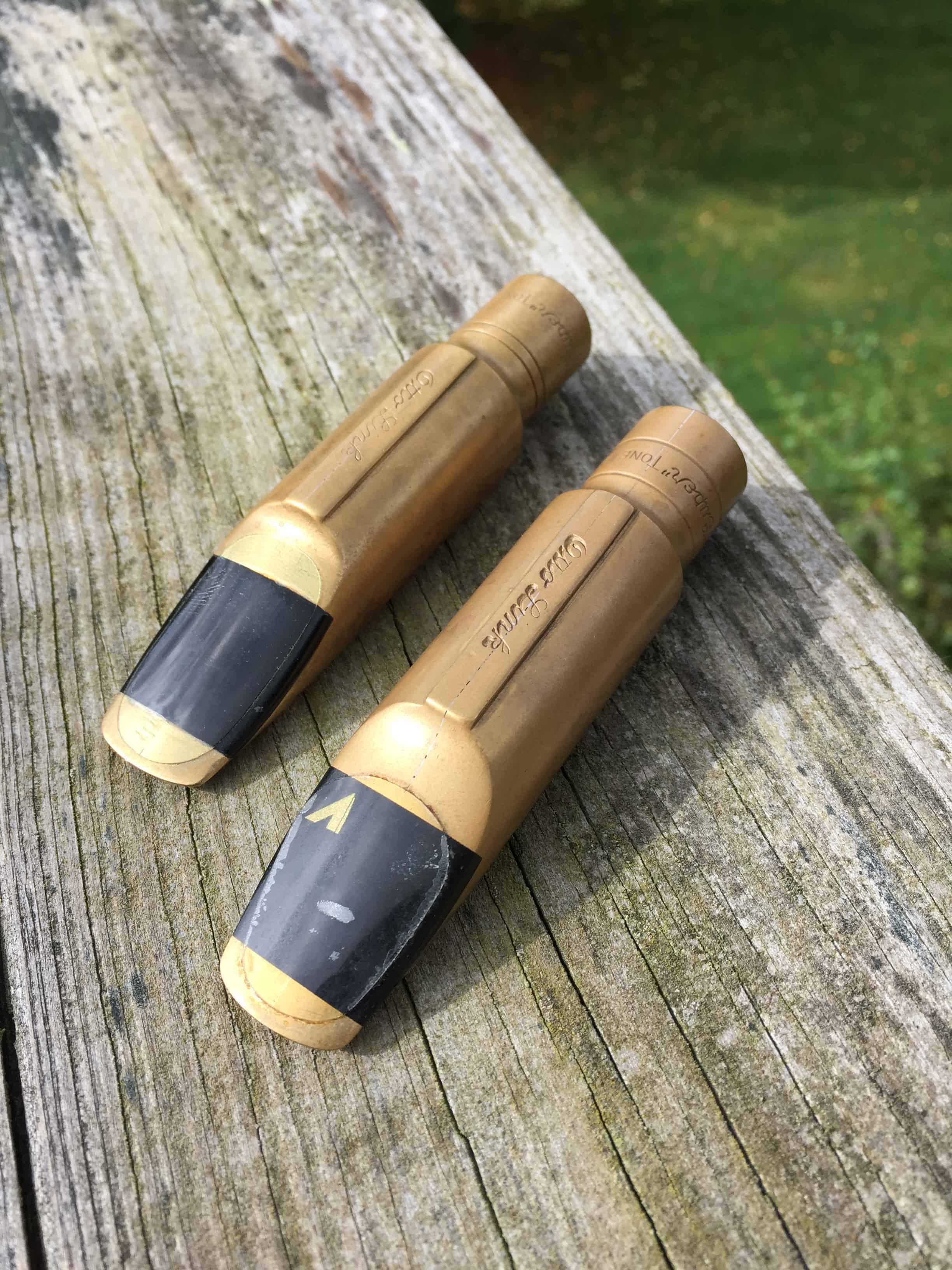

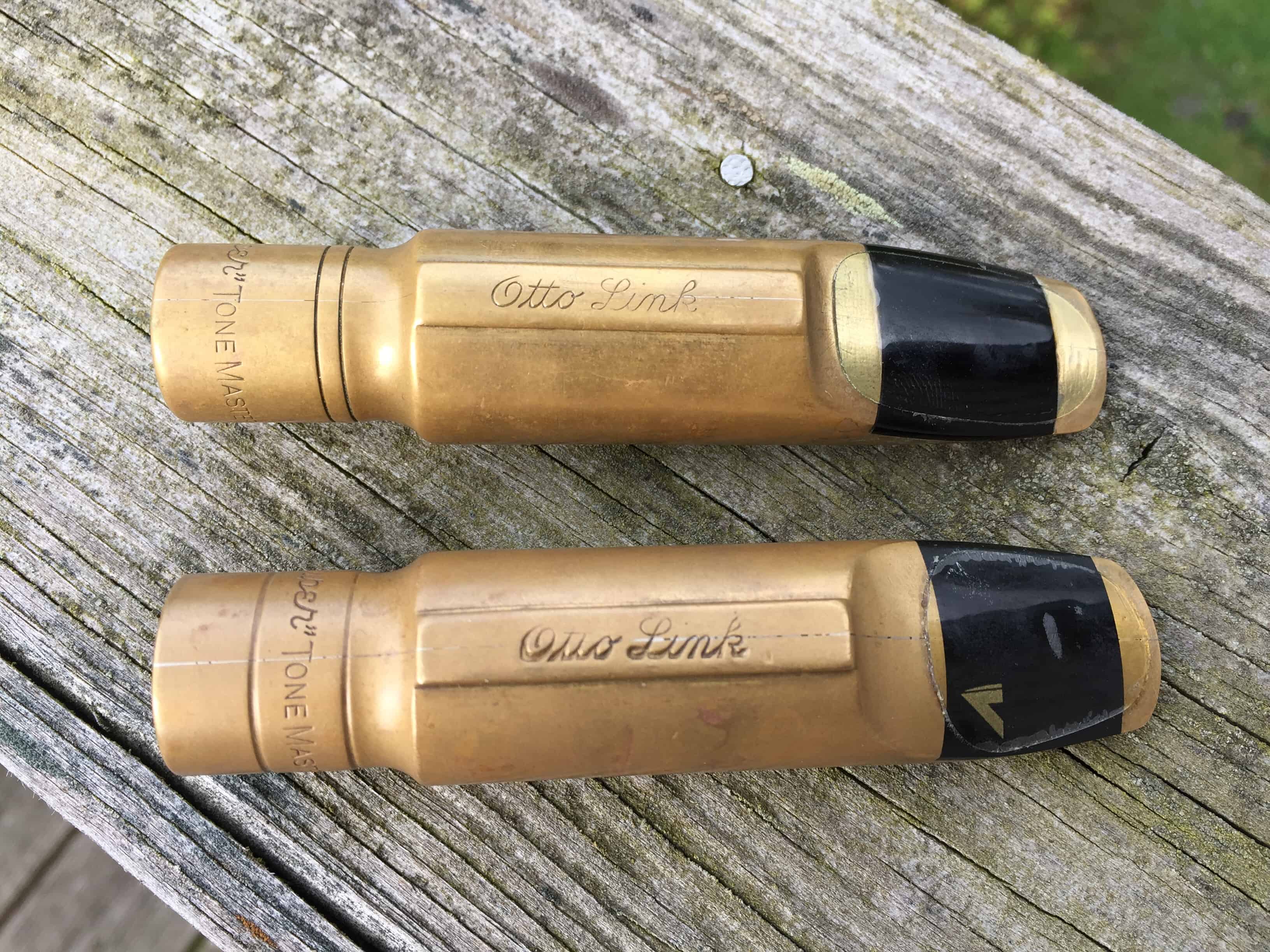
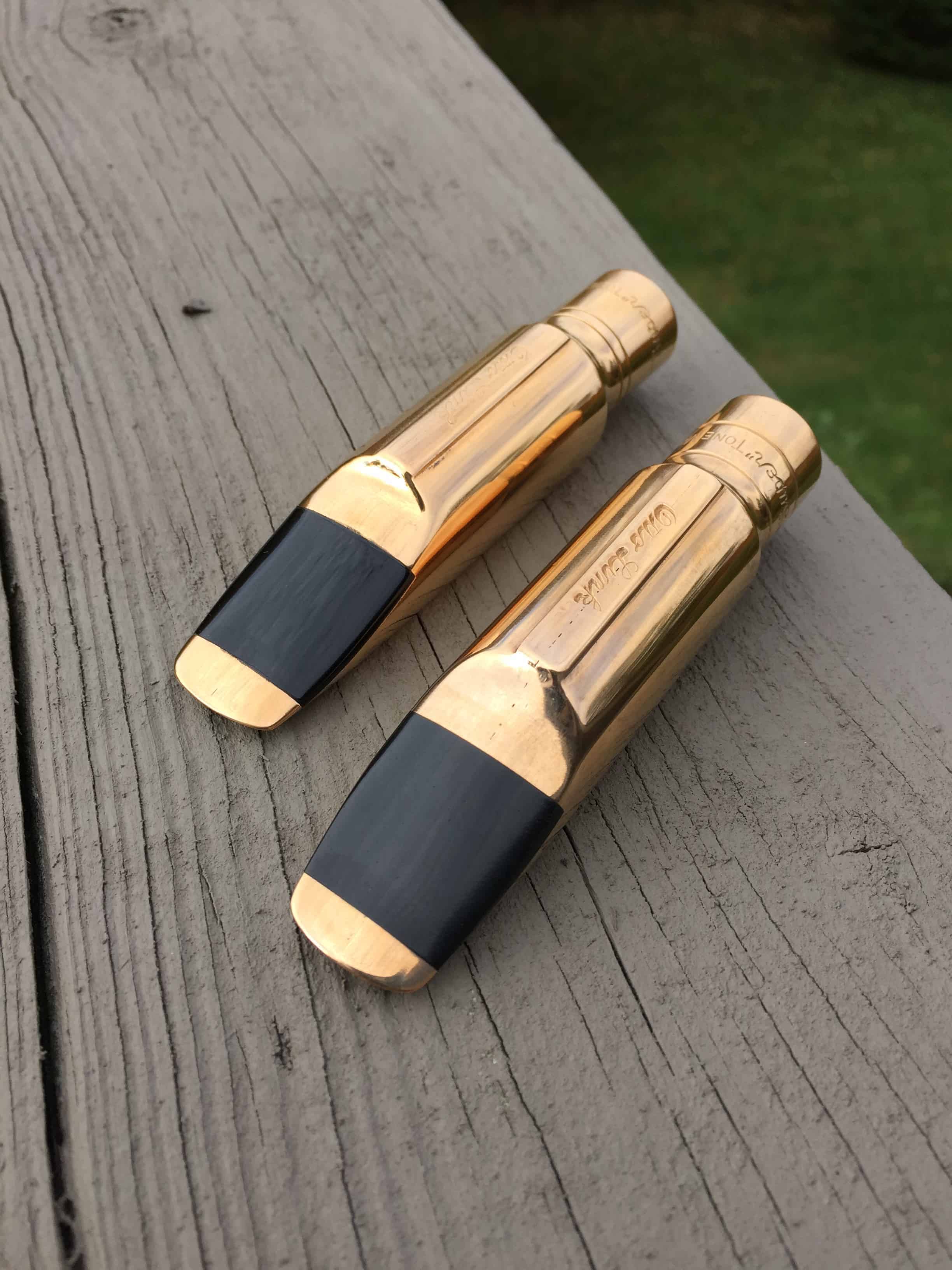
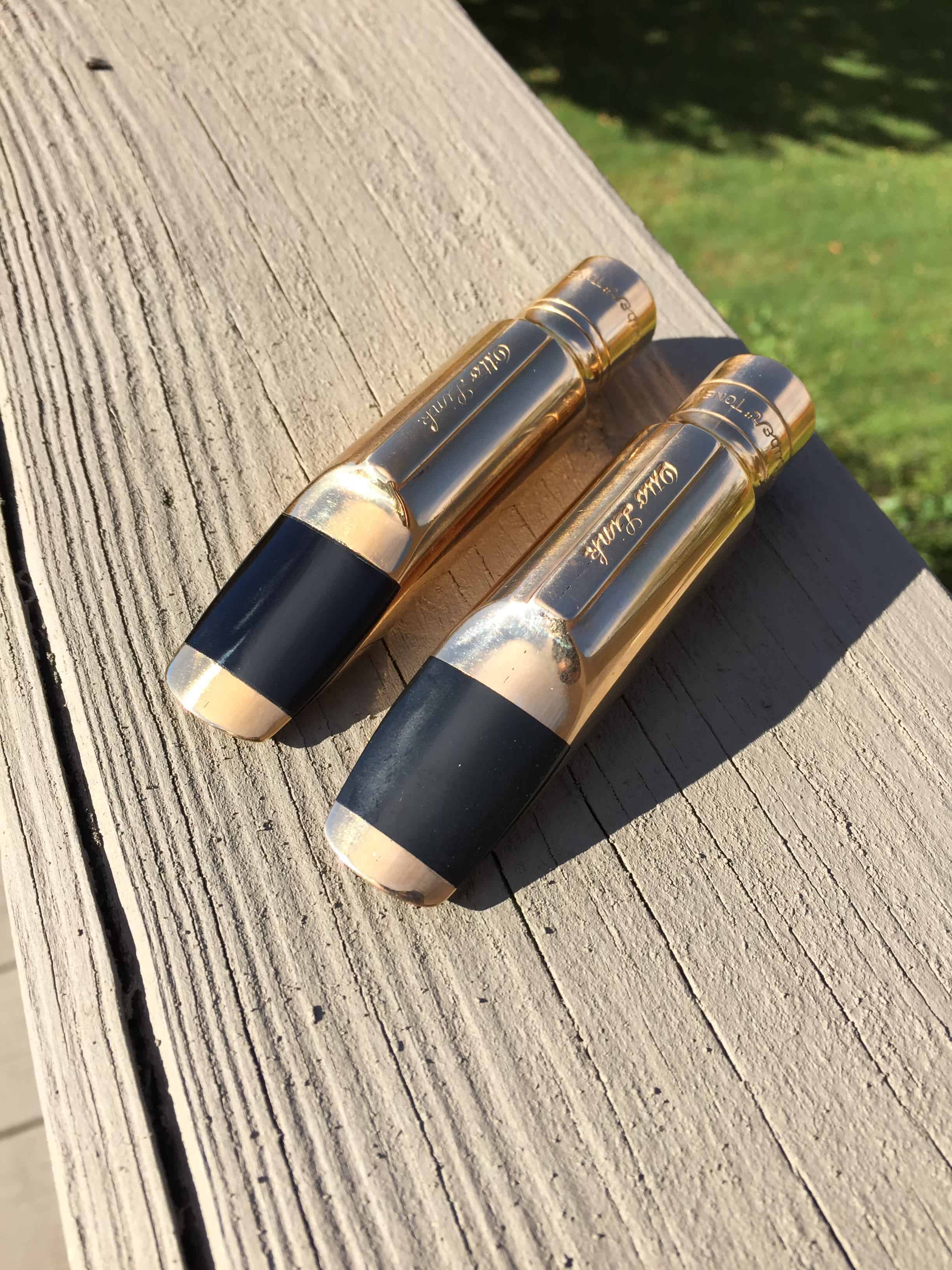
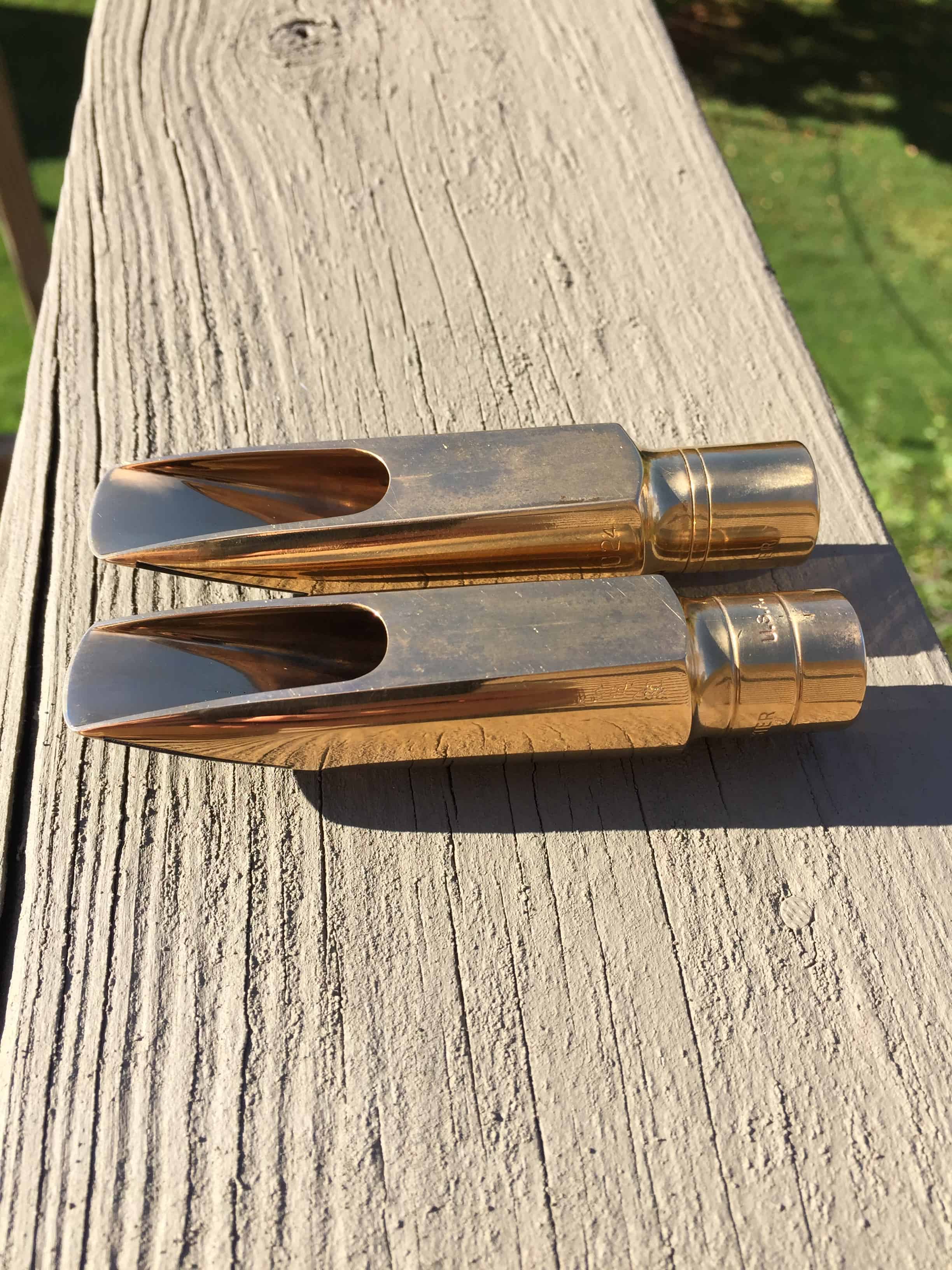
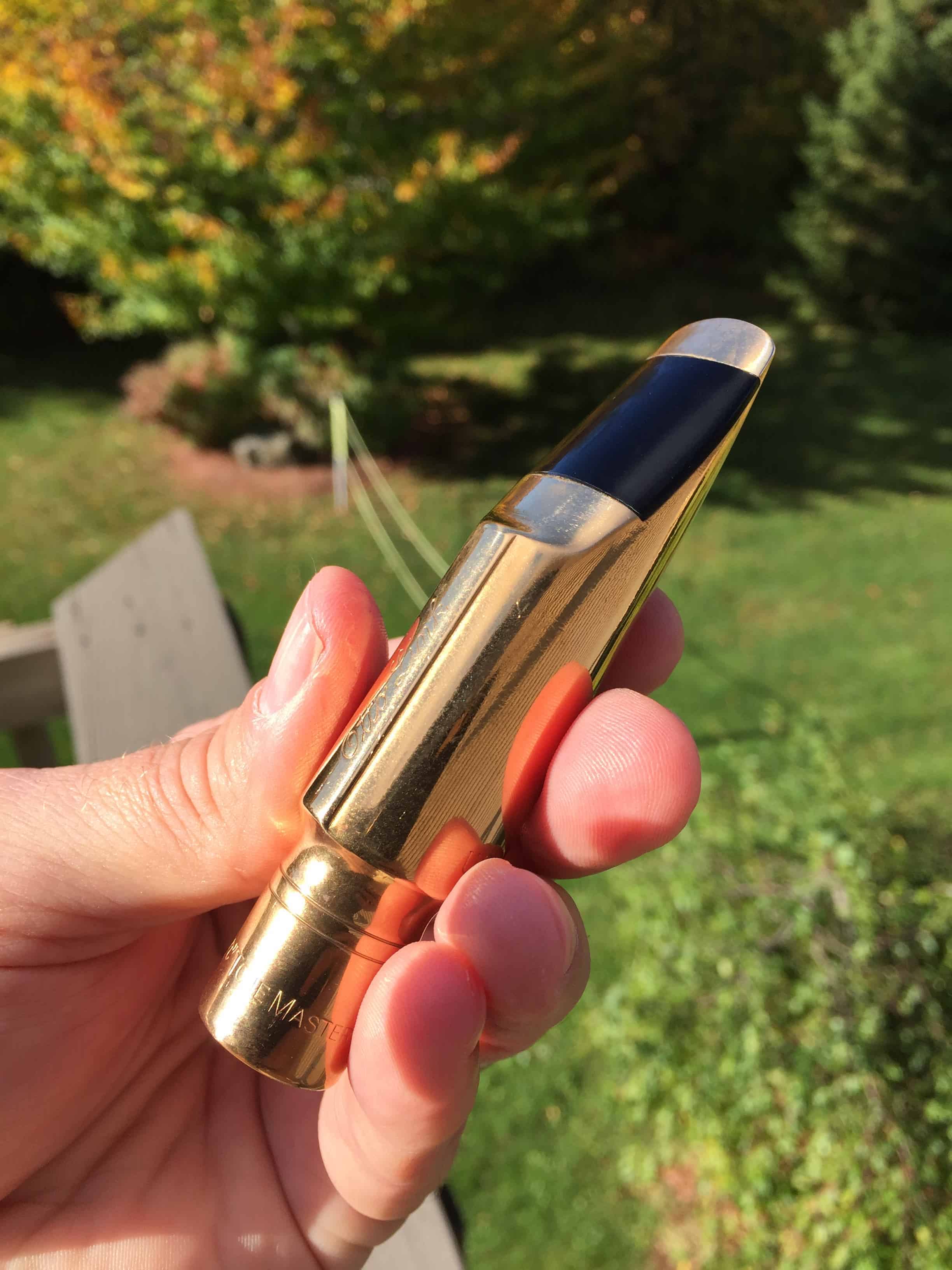



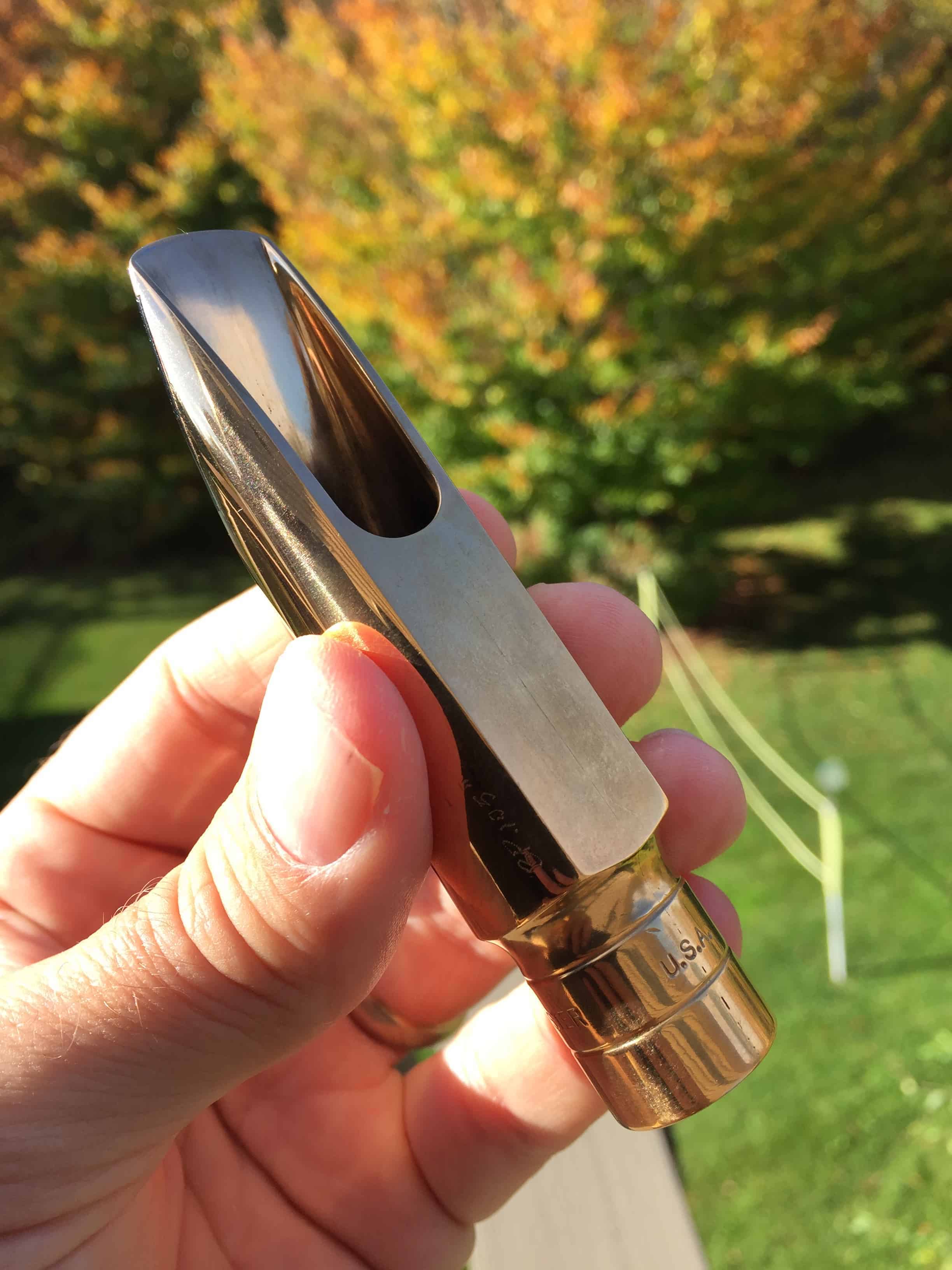
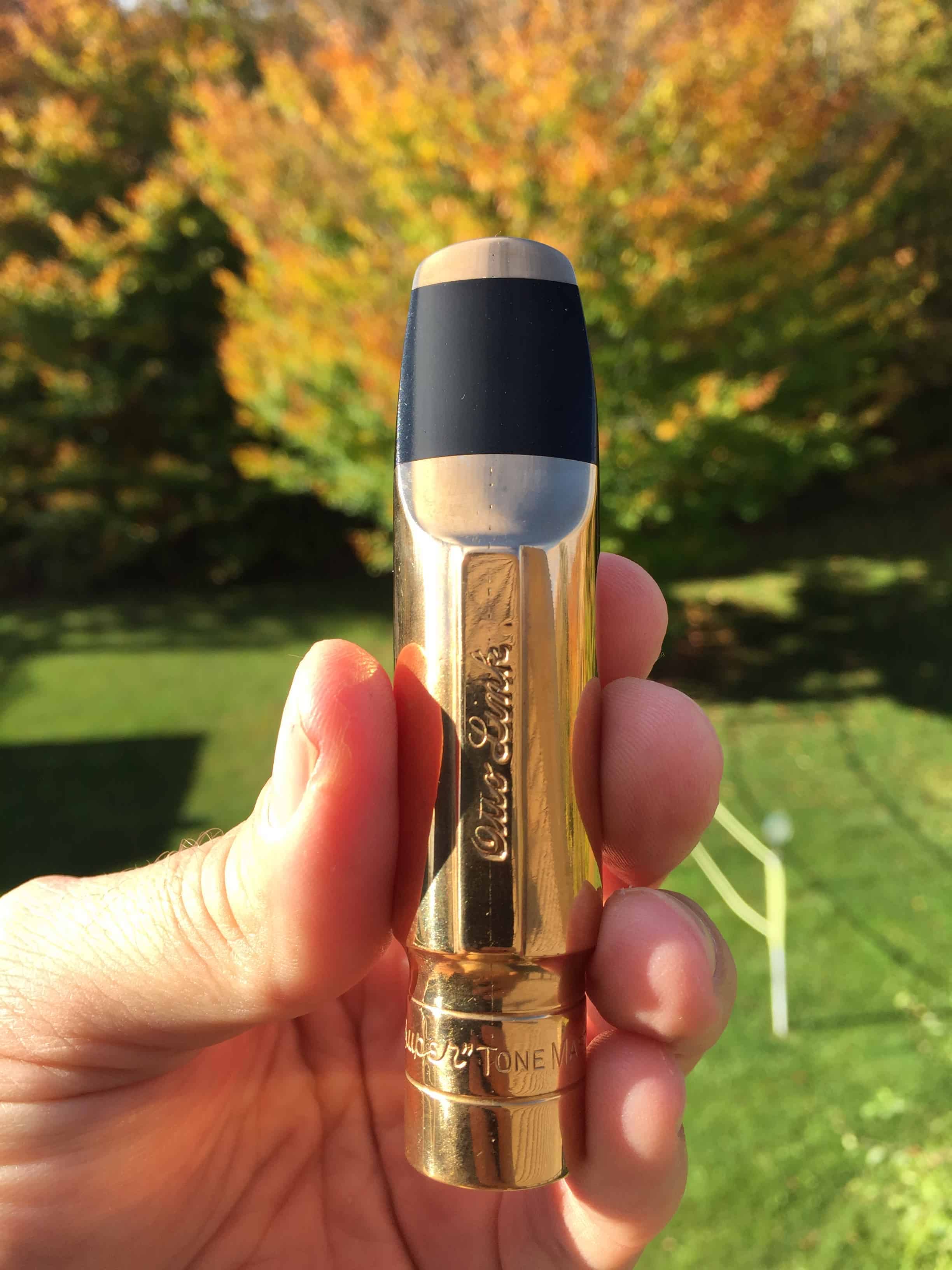



Matt IS a great communicator! I’ve dealt with another mouthpiece refacer who you had to pull teeth from to get any meaningful communication. Matt is a perfectionist and a good guy who is fast developing an excellent reputation.
Warren, I agree. I emailed Matt an EWI question a few weeks ago and he sent me back such a detailed response that it should have been in the EWI manual. He’s done the same when I have asked him about mouthpiece stuff. He is very knowledgeable and a great communicator………
I have difficulty playing my Gold Plated 7* Otto Link Soprano Sax metal mouthpiece in tune in the second and third octaves, I believe my embouchure grip is not sufficiently adaptable to pitching the higher notes in tune. It wavers in pitch continually. I bought my Mark VI Selmer Soprano sax in 1981 (last year of manufacture of that model). When using my Selmer letter E S80 ebonite mouthpiece I have no problems at all. Would you recommend changing the facing to a less open aperture? Is that possible or also too expensive?